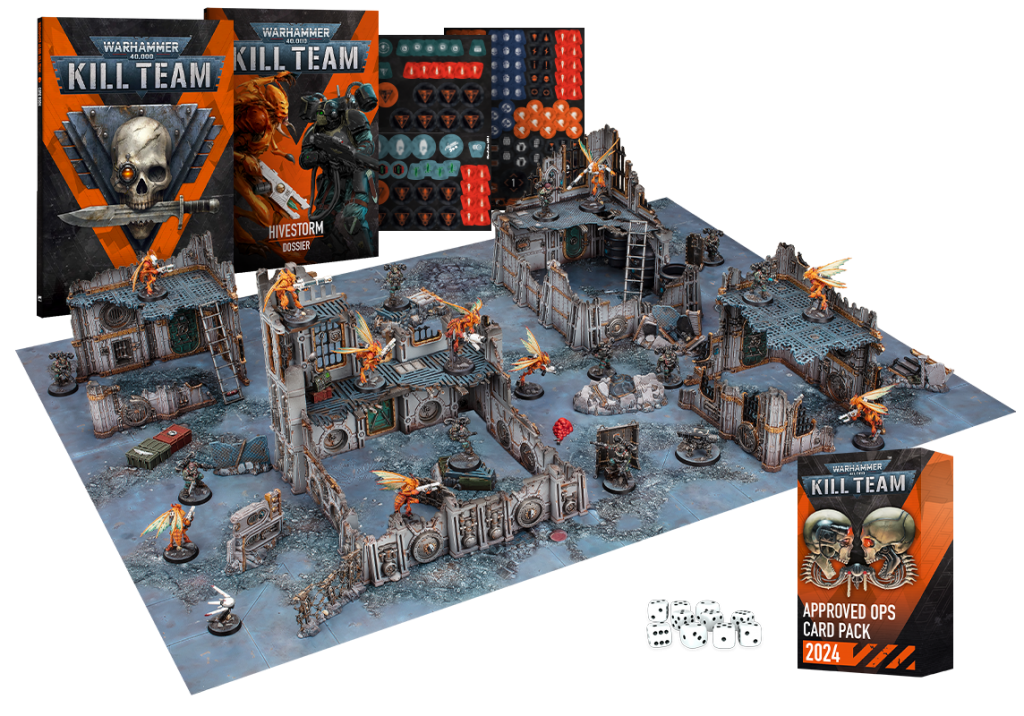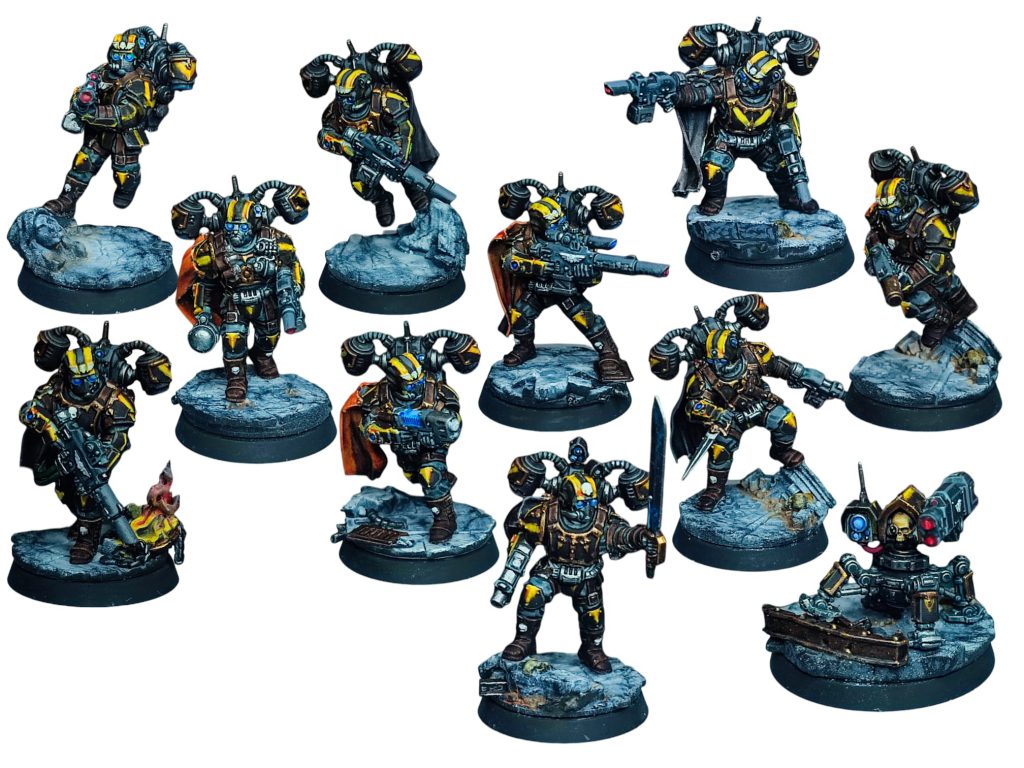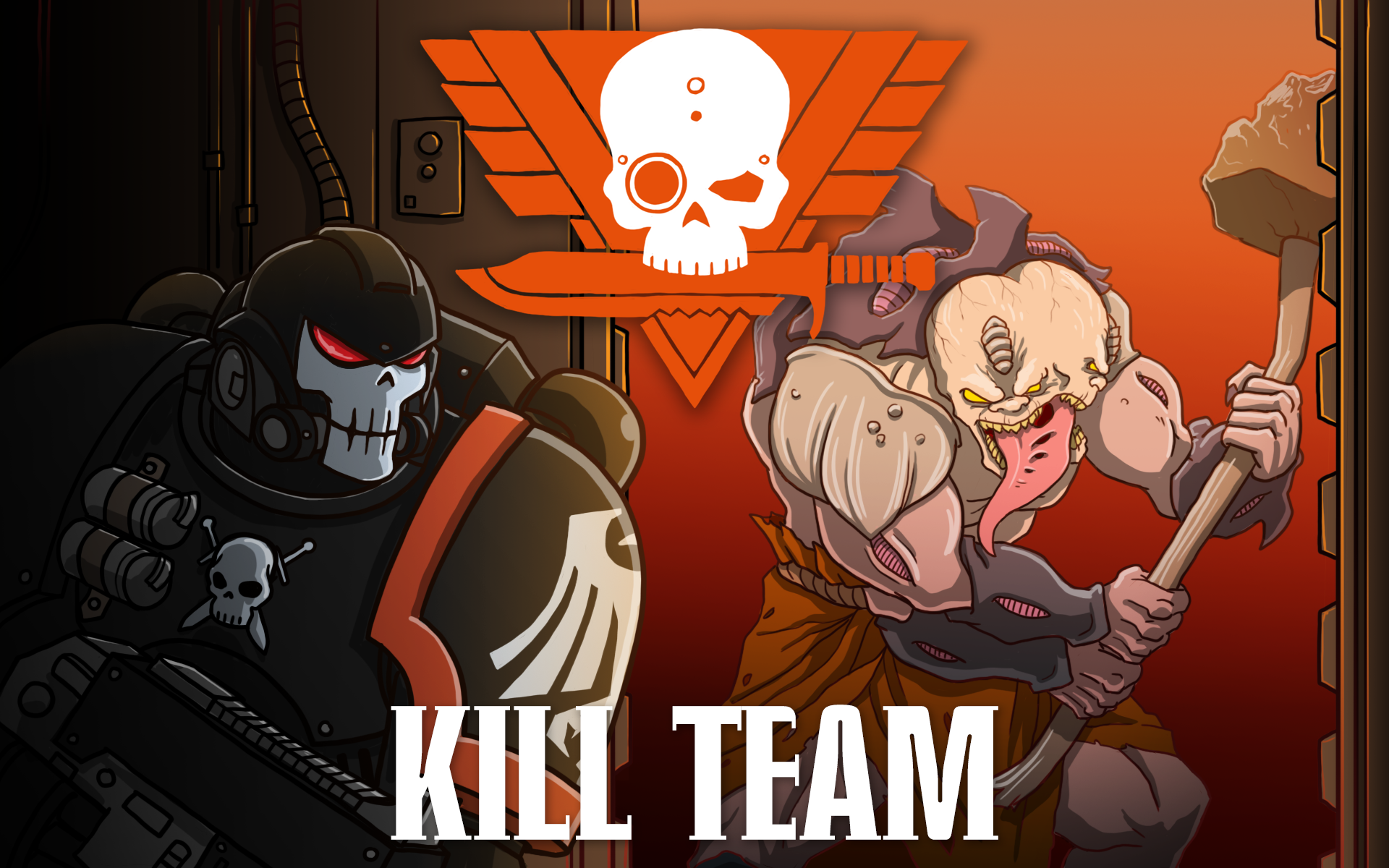The new edition of Kill Team has hit the streets, and we here at Goonhammer are very excited about it – as you can probably tell by the swathe of review content we put out on pre-order day, summarised on this post.
Along with other people on the community programme, I was invited (as Goonhammer’s representative) to a preview event at Warhammer World in mid-August. Our mission, should we choose to accept it – play the new Kill Team and see if we liked it. Playing games and chatting to other enthusiasts is not the most difficult assignment in the world, and I gladly accepted the chance to join in.
We began our day by being ushered into a locked room – absolutely no cameras – to be shown the contents of the new Kill Team: Hivestorm box. The box itself is impressive, with two great new teams and a set of the Killzone Volkus terrain, and seeing the studio models in the flesh was a treat. Our hosts chatted us through the contents before sitting us down for a full presentation – what is the new Kill Team about, what changes have they made, and why have they done so?

The actual content of the presentation is now old news, you’ve seen it all on Warhammer Community and on this very website – the new approach to Approved Ops, the disappearance of Spec Ops, the “Classified” format. What I think is more interesting about having sat through it is what it said about the game and the team’s vision for it. Although it was semi-public-facing, it had a strong feeling of being an internal pitch deck, and I would be unsurprised if it started life as exactly that. What came across from it was how clearly the designers had sat down and thought about what Kill Team is meant to be. From an outsider’s point of view, this kind of holistic assessment of the point and purpose of a game has often seemed like a Games Workshop weak spot, and Kill Team itself in its 2018 form may be the best example. Six years on, what I was seeing was the polar opposite – a really positive indicator for the future of the game.
After the presentation and the Q&A was over, it was time for us to get to grips and play some games. We were paired up for a Preliminary Op – the “get you started” missions in the core book – with my Mandrakes taking on some Brood Brothers. I should say at this juncture that I had played very little of the second edition of Kill Team (covid and early parenting devoured my gaming time), but I had a passing knowledge of the rules. What I found with 3rd edition is that things were much as I remembered them, but more clearly explained and streamlined – over in 40k world, the “simplified not simple” slogan got a lot of stick, but it does seem to be eminently true for this iteration of Kill Team. We rapidly got to grips with the core rules, and while I was a little overwhelmed by the sheer scope of what Mandrakes can do (I probably should have taken a simpler team along with me), it was a lot of fun and the tactical opportunities were readily apparent. It definitely felt like something that an experienced player could teach someone and have them confidently playing within a turn or two. The Mandrakes took the win, but then I found afterwards I’d been merrily cheating with an extra operative, so let’s call that one a learning experience.

After lunch, it was time for a new game mode, trying out the new Joint Ops. For this I was paired up with some suspiciously Tau-looking Phobos Marines. The way Joint Ops works if you’re playing co-operatively is that you each take half of your normal team, and then face off against a set number of wounds of enemy operatives chosen from a broad set of archetypes. Faced with a shelf full of Khorne Daemons, we opted to take on an all-melee team of Bloodletters and Flesh Hounds, roughly represented by Medium and Heavy Melee operatives.
The overriding way that the enemy team works in Joint Ops is via the Threat Principle, i.e. “do what’s worst for you,” with a small decision tree for each type of operative to suggest what actions they’ll ordinarily take. In our game, this mostly involved Bloodletters smashing the heads off things that strayed too close. The group had some lively debate after our games as to how well this system worked compared to the one in the Darktide board game, which is a bit more structured and card-driven and only uses the Threat Principle for making decisions of judgment – the game’s made that enemy operative shoot, so now you need to pick what they shoot at, for example, whereas the Kill Team version leaves it open to the players whether the enemy shoots at all. Broadly I think the Darktide version has some strengths as a way to play a game where the enemy can surprise you a little, and is more like playing against someone, whereas Joint Ops has huge strengths as a teaching tool. Forcing you to think about what your enemy team might choose to do is a great way to make you think about what a live opponent might choose to do, and teaches fundamental game skills. It also means that opponent skill scales naturally; if like me you’re bad at the game, then your opponent is also bad, whereas a very strong player can play a very good game against themselves. The co-operative mode was also a really useful chance to play alongside a much more experienced player, who could point out rules mistakes on my part and offer useful insight on how to play better, without an adversarial framing.

What the long-term prospects for the mode are is an interesting question. As I said, solo and co-operative play are increasingly popular in board game circles, and I think the framework where where you can easily throw an opposing team together out of whatever models you have to hand – and they’re not too complicated to play – is a useful one. There’s value in it for streamers, whether as a way to show off how to use a team while keeping the other side uncomplicated, or as a framework for narrative campaigns (and again this is something that players of Fallout: Wasteland Warfare have done). I think there’s also scope here for more cinematic game modes to exist, that might not fit within the scope of a normal Kill Team game where balance is a primary consideration – letting players team up to take down a rampaging Dreadnought or Carnifex, for example, or play out ‘meat grinder’ missions where it’s inevitable that the player will lose and the goal is to see how far they get. These kinds of things often sound appealling as a narrative experience but aren’t a ton of fun to actually play when there’s an adversarial element to them, so approaching them co-operatively could be a more interesting framing.
With Joint Ops done, it was time for a final few words and then to be released from our locked room and sent home. I left with a very positive impression of the new edition, though it’s easy to have a good view of things when you’ve had only a limited look at them. I’m hopeful that this will bear out as more people get to grips with the game, and I look forward to playing much more of it.
Have any questions or feedback? Drop us a note in the comments below or email us at contact@goonhammer.com. Want articles like this linked in your inbox every Monday morning? Sign up for our newsletter. And don’t forget that you can support us on Patreon for backer rewards like early video content, Administratum access, an ad-free experience on our website and more.


